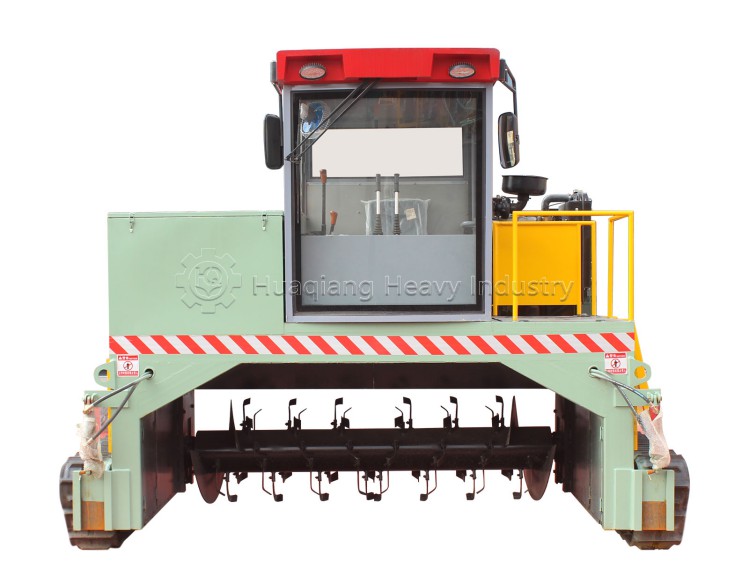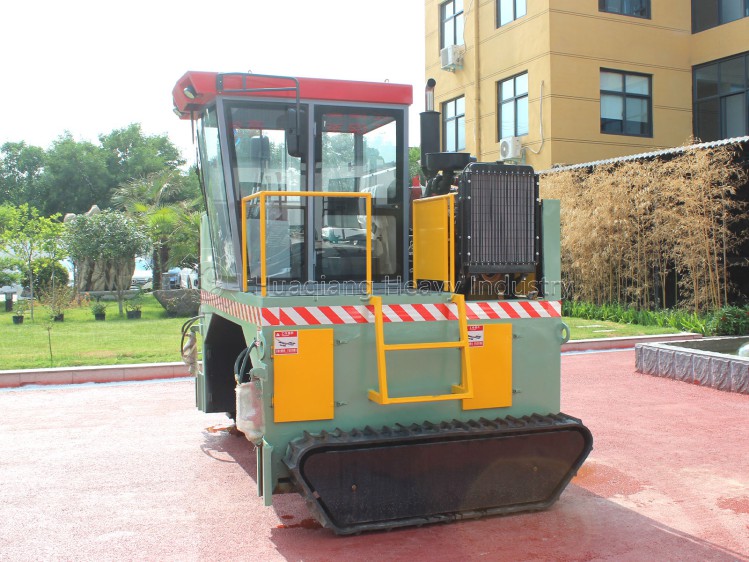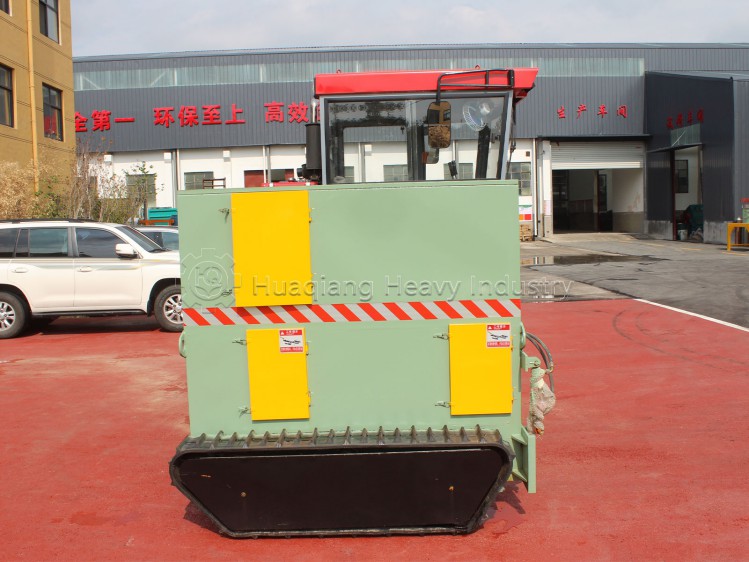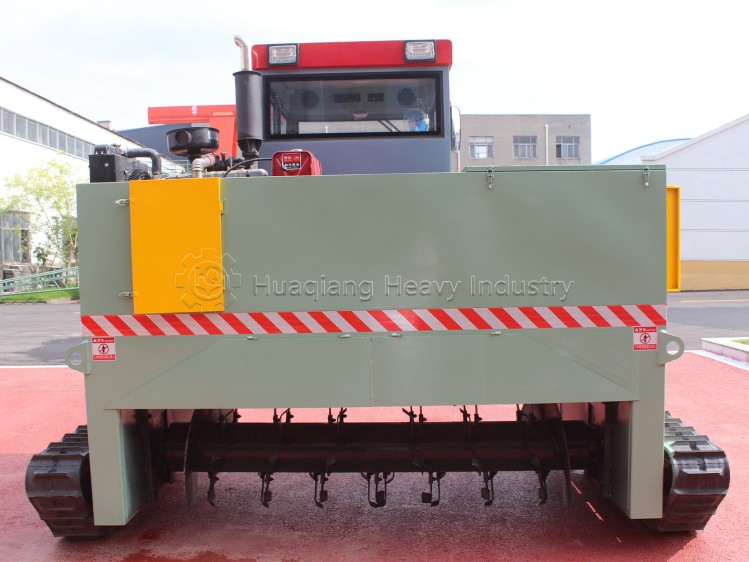




A windrow compost turner is a material fermentation processing device that utilizes a crawler-type walking mechanism. It is primarily used in organic fertilizer production to turn and stir various organic materials, creating a suitable fermentation environment. Its core operating principle is that the crawler structure enables flexible movement of the equipment across complex sites. Simultaneously, the turning teeth or spiral blades on the mechanical arm turn the accumulated material, allowing it to fully contact the air, regulating temperature and humidity, and accelerating microbial decomposition and maturation.
Thanks to its crawler-type walking design, this equipment can adapt to muddy and uneven fermentation sites. Compared with wheeled compost turners, it has stronger terrain adaptability and is widely used in strip-type fermentation operations in large-scale organic fertilizer production bases, farms and municipal organic waste treatment sites.
What raw materials can be fermented by windrow compost turning machine?
The windrow compost turner has a wide range of adaptability to a variety of organic materials and can efficiently process the following raw materials:
Livestock and poultry manure:This includes high-density organic materials such as chicken manure, pig manure, cow manure, and sheep manure. The powerful turning of the windrow compost turner can break up the compacted state of the manure. Through ventilation and temperature increase during the turning process, it effectively kills pathogens, parasite eggs, and weed seeds in the manure, while also reducing ammonia emissions and eliminating the stench of manure.
Crop straw:
Industrial organic waste:
Municipal organic waste:
Sludge:
What are the characteristics and advantages of windrow compost turners when fermenting raw materials?
Compared with other compost turning equipment, windrow compost turning machine has the following advantages when fermenting raw materials:
Strong terrain adaptability
The crawler-type walking design reduces the ground pressure of the equipment, and it can move freely on muddy, soft and complex sites with a slope of ≤15° without laying special tracks. It is suitable for open-air windrow fermentation, and the site utilization rate is more than 30% higher than that of trough-type compost turners.
Wide turning range
The hydraulic arm can flexibly adjust the height and width of the compost turning machine, and can handle stacks 1-2.5 meters high and 2-6 meters wide. A single device can turn 50-150 tons of materials per hour, and its operating efficiency is 1.5-2 times that of a single-screw compost turning machine.
High mixing uniformity
The turning teeth flip the material upward from the bottom, and combined with the lateral pushing when the equipment is moving, the material turning rate reaches more than 95%, avoiding local compaction or uneven fermentation. The temperature distribution deviation of the material is ≤3℃, and the composting consistency is good.
High operational flexibility
Equipped with a hydraulic control system and a flexible steering mechanism, it can achieve on-the-spot steering and small-radius turns, and can flexibly shuttle between the windrows. It is especially suitable for alternating operations of multiple rows of windrows, reducing the equipment's idle time.
Wide range of applicable raw materials
Whether it is sludge with high water content, sticky livestock and poultry manure, or coarse fiber straw materials, they can be efficiently processed by adjusting the turning depth and speed without replacing core components. The raw material adaptability is better than traditional trough-type compost turners.
How to use windrow compost turner in fertilizer production line?
The windrow compost turner is the core equipment in the raw material fermentation process in the fertilizer production line. Its application runs through the early processing stage of organic fertilizer production, as follows:
Connecting pretreatment and deep processing
In the fertilizer production line, raw materials that have undergone pretreatment (crushing, mixing, and carbon-nitrogen ratio adjustment) are transported to the fermentation area and stacked into windrows. A crawler-type compost turner then turns and ferments the windrows. The composted materials are then conveyed by conveyor to subsequent processes (crushing, granulation, drying, etc.), forming a continuous "pretreatment - fermentation - further processing" process. This efficient turning process provides high-quality raw materials for subsequent processing.
Achieve large-scale continuous fermentation
For large-scale fertilizer production lines (with an annual output of more than 50,000 tons), windrow compost turners can serve multiple groups of windrows simultaneously, achieving continuous production through a "multi-zone rotation" model: zone one for new material loading, zone two for high-temperature fermentation, and zone three for cooling and composting. The equipment operates in a fixed cycle, with an average daily processing capacity of 800-1,500 tons, meeting the needs of large-scale production.
Matching the production line rhythm
The equipment's travel speed and compost turning frequency are infinitely adjustable via the electronic control system, allowing for flexible adjustments to the fermentation schedule based on the raw material supply rate and back-end processing capacity. For example, as pelletizer capacity increases, the compost turning frequency can be increased to accelerate material maturation, ensuring that the fermentation process matches the overall production line rhythm.
Adapt to diversified production models
It can independently complete open-air windrow fermentation or integrate with fermentation silos, conveyors, and other equipment to form a semi-enclosed production line. For scenarios requiring mobile operations (such as livestock farms and temporary waste disposal sites), windrow compost turners can be flexibly moved with the raw material production site, eliminating the need for fixed installation and enhancing the production line's mobility.
1. The machine adopts hydraulic operation system, tie-rod type steering wheel operation and crawler-type travelling. The working width is up to 3m and the height can reach 1.3m.
2. Crawler-type compost turner has strong working capacity and large production, suitable for large organic fertilizer factories.
3. This turner is sturdy and durable, with strong power and advanced technology, thus the machine is recognized as the strong one among compost turner.
4. Its travelling relies on crawler, the turning roller adopts hydraulic lift adjustment, with high degree of automation and easy operation.
5. This compost turner is a kind of professional turning equipment of transforming organic materials into organic fertilizer through aerobic fermentation.
How does a windrow compost turner compost organic fertilizer raw materials?
The process of composting organic fertilizer raw materials with a windrow compost turner must be combined with its terrain adaptability advantages and follow the laws of biological fermentation. The specific steps are as follows:
Raw material pretreatment
Collected organic materials are sorted and processed: livestock and poultry manure is air-dried to a moisture content below 65%; straw is pulverized to 5-10 cm in length; and industrial waste is cleaned of impurities such as metal and plastic. The raw materials are mixed at a carbon-nitrogen ratio of 25-30:1. The formula is optimized by adding straw (to adjust the carbon content) or manure (to adjust the nitrogen content), ultimately controlling the moisture content to 55%-60% (the material forms a ball when held in the hand and falls apart when dropped to the ground).
Stacking
At the fermentation site, pretreated raw materials are stacked into trapezoidal windrows. The windrows are 3-5 meters wide at the bottom, 1.5-2.5 meters wide at the top, and 1-1.8 meters high. The length varies depending on the site and production volume (typically 10-100 meters). A 1.5-2 meter passage is reserved between windrows to facilitate the passage of a crawler-type compost turner and to ventilate the material.
Turning and fermentation
Start the windrow compost turner and adjust the turning mechanism's lift height according to the height of the windrow, ensuring the turning teeth penetrate 10-20 cm into the bottom of the material. The machine moves at a constant speed along the length of the windrow. The turning teeth toss the material from the bottom upward, bringing the bottom layer of material to the surface. This layer then mixes with the middle layer, ensuring thorough mixing and ventilation of the material.
During the initial fermentation period (1-3 days), the compost is first turned when the material temperature reaches 50-60°C. During the high-temperature period (4-10 days), when the temperature reaches 60-70°C, the compost is turned every 1-2 days to kill pathogens. During the cooling period (11-20 days), when the temperature drops to 40-50°C, the compost is turned every 2-3 days to promote humus formation. The entire fermentation cycle lasts 15-25 days, and the specific time can be adjusted according to the ambient temperature and the maturity of the material.
Maturity judgment
When the material temperature drops to near ambient temperature (±5°C), the color turns dark brown, the texture becomes loose, there is no obvious odor, and it emits a fresh earthy fragrance, it indicates that the material is mature. At this time, the windrow compost turner can push the mature material to the designated area for subsequent crushing, screening and granulation.
Equipment composition of windrow compost turner
The windrow compost turner is composed of several key components that work together to ensure efficient compost turning operations in complex terrain. The specific components are as follows:
Rack structure:
crawler walking device:
Compost turning mechanism:
Powertrain:
hydraulic system:
Electronic control system:
Assistive devices:
How to regularly maintain the windrow compost turner to extend its service life?
In order to ensure the stable operation of the windrow compost turner and extend its service life, the following regular maintenance measures need to be performed:
Regular inspection of components
Before starting the machine every day, check whether the track shoe connecting bolts are tightened and whether the track tension is appropriate (droop 20-30mm); check whether the turning teeth are loose or broken, and whether the hydraulic pipelines are leaking; test whether the handles on the operating table are sensitive and whether the sensor display is normal.
Weekly inspection of travel drive
| Windrow Compost Turning Machine | ||||
Model |
HQ-FD 2500 | HQ-FD 2600 | HQ-FD 3000 | |
Width(mm) |
HQ-FD 2500 | 2600 | 3000 | |
Height(m) |
500-1000 | 500-1100 | 500-1200 | |
Stack spacing (m) |
1.0-1.2 | 1.0-1.2 | 1.0-1.2 | |
Max Particle Size (mm) |
250 | 250 | 250 | |
Power |
R4102 Turbocharged 90HP Diesel Engine |
R4105 Turbocharged 105HP Diesel Engine |
R6105 Turbocharged 136HP Diesel Engine |
|
| Rated power speed(r/min) | 2200 | 2200 | 2200 | |
| Working speed(m/min) | 6-18 | 6-18 | 6-18 | |
| Driving speed(m/min) | 50 | 50 | 50 | |
| Processing capacity(m3/h) | 400-600 | 600-800 | 1000-1200 | |
| Overall size(m) | 3.64×2.6×2.7 | 3.75×2.6×2.7 | 4.36×2.75×2.95 | |